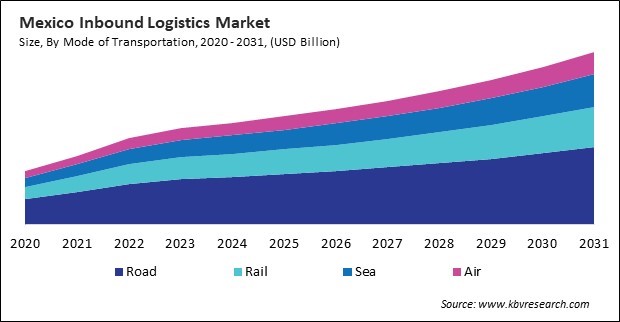The North America Inbound Logistics Market would witness market growth of 6.7% CAGR during the forecast period (2024-2031).
The US market dominated the North America Inbound Logistics Market by Country in 2023, and would continue to be a dominant market till 2031; thereby, achieving a market value of $544,887.1 million by 2031. The Canada market is experiencing a CAGR of 8% during (2024 - 2031). Additionally, The Mexico market would exhibit a CAGR of 7.8% during (2024 - 2031).

These logistics is a crucial component of the supply chain that involves transporting, storing, and delivering goods from suppliers to manufacturers, distributors, or retailers. It refers to procuring raw materials, components, and goods required for production or sale and delivering them to the right location at the right time. These logistics is vital for maintaining smooth operations in various industries.
As industries grow and evolve, the demand for streamlined, cost-effective inbound logistics solutions has surged. Companies are looking for ways to optimize operations, reduce transportation costs, improve supplier relationships, and ensure product availability while maintaining high service levels. This has led to the development of innovative technologies, strategic partnerships, and new business models to enhance the efficiency and effectiveness of inbound logistics systems.
In Mexico, the vast scale of the retail industry, particularly Walmart de Mexico’s dominance, necessitates an efficient and reliable inbound logistics network to handle the large volumes of goods flowing into the country. As retailers expand and evolve to meet consumer demands, particularly in urban areas, the need for sophisticated supply chain solutions becomes more critical. Retailers rely on robust inbound logistics to ensure that goods are delivered promptly to stores nationwide, with streamlined systems that reduce lead times and improve inventory management. In Canada, the rapid rise of e-commerce is significantly impacting these logistics, particularly as consumers demand faster delivery times and a wider range of products. As e-commerce sales are expected to generate USD 40.3 billion by 2025, the logistics sector must scale accordingly to accommodate the growing flow of goods, including handling larger volumes of parcels and freight entering the country. Expanding e-commerce requires flexible logistics networks, such as decentralized fulfilment centers, advanced warehousing solutions, and enhanced last-mile delivery systems. Thus, in both Mexico and Canada, the growth of retail and e-commerce is creating a heightened demand for more efficient, integrated these logistics networks.
Free Valuable Insights: The Inbound Logistics Market is Predict to reach USD 2542.59 Billion by 2031, at a CAGR of 7.4%
Based on Service, the market is segmented into Transportation, Warehousing & Storage, Inventory Management, Procurement Services, and Other Service. Based on End Use, the market is segmented into Retail & e-commerce, Manufacturing, Automotive, Food & beverage, Electronics, Pharmaceuticals, and Other End Use. Based on Mode of Transportation, the market is segmented into Road, Rail, Sea, and Air. Based on countries, the market is segmented into U.S., Mexico, Canada, and Rest of North America.
By Service
By End Use
By Mode of Transportation
By Country
Our team of dedicated experts can provide you with attractive expansion opportunities for your business.

